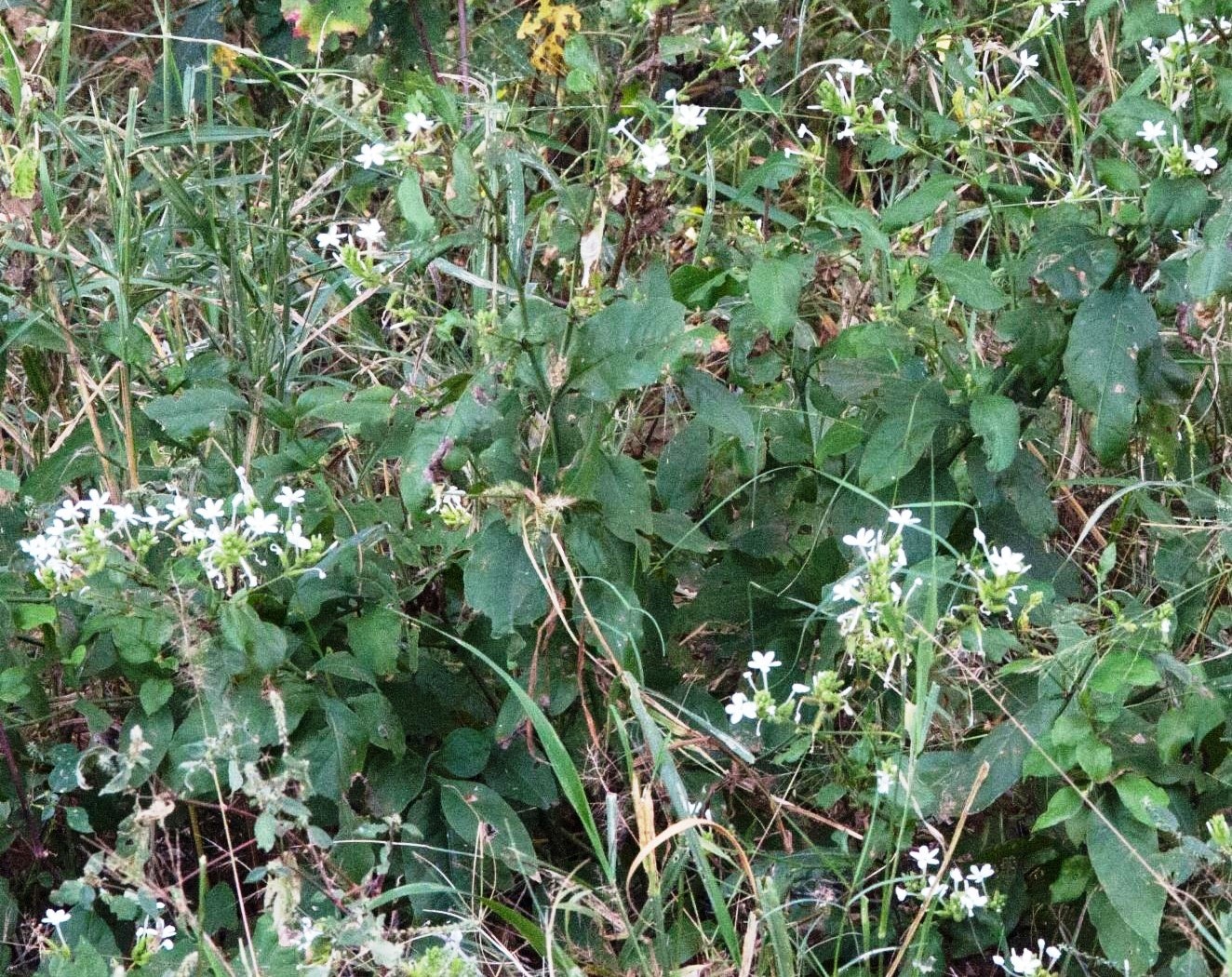Plumbago zeylanica

|
|
Plumbago zeylanica Common Names: Ceylon Leadwort, Doctorbush, Wild
Leadwort, White-flowered Leadwort, Chitrak Scientific
Classification Kingdom: Plantae Clade: Angiosperms Clade: Eudicots Order: Caryophyllales Family: Plumbaginaceae Genus: Plumbago Species: P. zeylanica Binomial Name: Plumbago zeylanica L. Synonyms: Plumbago scandens L., Plumbago rosea sensu auct. (misapplied), Thela zeylanica (L.) Raf. Morphological Description Plumbago zeylanica is a perennial herbaceous plant or subshrub with a sprawling
or semi-climbing habit, typically reaching heights of 0.5–2 m. It is
characterized by: · Stem: Slender, flexible, often scrambling or prostrate, with a
woody base and glandular hairs · Leaves: Alternate, oblong to ovate (4–8 cm long, 2–4 cm wide),
simple, entire, green, with a slightly sticky texture due to glandular
secretions · Flowers: White or occasionally pale blue, tubular (1–2 cm long),
arranged in terminal or axillary racemes (10–25 cm long), with sticky calyces
aiding seed dispersal · Fruit: Oblong capsule (5–8 mm long), enclosed in a persistent,
glandular calyx, containing a single dark brown seed The plant’s sticky
calyces and vibrant flowers make it a distinctive species in its tropical
habitats (Vishnukanta & Rana, 2021). Distribution and Habitat Plumbago zeylanica is native to tropical and subtropical regions across Africa,
Asia, and Australia, with a broad pantropical distribution due to
naturalization. It spans: · Africa: Nigeria, Ghana, South Africa, often in coastal scrublands
and savannas · Asia: India, Sri Lanka, Southeast Asia, thriving in dry forests
and shrublands · Australia: Northern regions, in open woodlands and disturbed sites It prefers full sun to
partial shade, well-drained sandy or loamy soils (pH 6.0–7.5), and annual
rainfall of 500–1,500 mm, commonly occurring at elevations from sea level to
1,000 m (Shukla et al., 2021). Ethnopharmacology Plumbago zeylanica. commonly known as Ceylon leadwort or chitrak in Ayurveda, is
a medicinal plant with a pantropical distribution. It has been traditionally
utilized for its diverse therapeutic properties, which have been substantiated
by various pharmacological studies. The plant exhibits notable antibacterial
and antifungal effects, supporting its traditional use in treating infections.
It also possesses anti-inflammatory and analgesic properties, beneficial in
alleviating inflammation-related conditions. The root extracts demonstrate
significant antioxidant activity, contributing to cardiotonic,
hepatoprotective, and neuroprotective effects. Studies indicate antidiabetic
potential, suggesting a role in managing blood sugar levels, and research
highlights cytotoxic effects against various cancer cell lines, indicating
potential as an anticancer agent. Additionally, the plant has shown
hepatoprotective properties, supporting liver health, and has been
traditionally used to enhance digestion and treat gastrointestinal issues such
as constipation and indigestion. Furthermore, it exhibits wound healing
properties, making it useful in treating cuts and wounds. While these medicinal
attributes underscore the therapeutic potential of Plumbago zeylanica, further
clinical research is necessary to fully establish its efficacy and safety
profiles. As with any medicinal plant, it should be used with caution, and
consultation with healthcare professionals is recommended before incorporating
it into therapeutic practices. · Anti-inflammatory: In India, root pastes treat rheumatism and
joint pain. Ethanol extracts reduce paw edema by 50–60% in rats at 200 mg/kg,
linked to plumbagin’s inhibition of NF-κB (Checker et al., 2012). · Antimicrobial: In Nigeria, leaf decoctions combat skin infections. Methanol
extracts inhibit Staphylococcus aureus (MIC 0.25 mg/mL) and Escherichia coli (MIC 0.5 mg/mL), due to naphthoquinones
(Mgbeahuruike et al., 2017). · Wound Healing: In Ethiopia, bark poultices heal wounds. Aqueous extracts
enhance collagen synthesis in vitro, supporting traditional use (Teshome et
al., 2009). · Anticancer: In Sri Lanka, roots treat tumors. Plumbagin induces
apoptosis in HeLa cells (IC₅₀ 10.49 µg/mL), downregulating EGFR (Nair et al.,
2020). · Antifertility: In South Africa, root extracts are abortifacients. Ethanol
extracts disrupt the estrous cycle in rats, prolonging diestrus by 48–72 hours
at 400 mg/kg (Edwin et al., 2009). ⚠ Toxicity Profile: Plumbagin (0.1–0.5% dry weight) is toxic, with
an oral LD₅₀ of 65 mg/kg in rats, causing hepatotoxicity and nephrotoxicity at
high doses (>500 mg/kg). The sap irritates skin, causing blisters (PII 2.0),
and internal misuse risks gastrointestinal distress. Use requires professional
oversight (Tyagi & Menghani, 2014). Phytochemistry The plant’s medicinal
potency is driven by its diverse phytochemicals: · Naphthoquinones: Plumbagin (0.1–0.5%), zeylanone, key to
anti-inflammatory and anticancer effects · Flavonoids: Quercetin, kaempferol (0.05–0.2%), with antioxidant
properties · Alkaloids: Present in roots, enhancing antimicrobial activity · Triterpenoids: Lupeol, sitosterol, supporting wound healing These compounds,
identified via HPLC and GC-MS, underpin its broad therapeutic applications (Vishnukanta
& Rana, 2021). Additional Uses · Cultural: In India, roots stain skin for traditional tattoos and dye
textiles red · Ecological: Stabilizes soil in disturbed tropical landscapes · Ornamental: Grown for its cascading white flowers in gardens References
External Links More Pictures
|
|
| Compounds of Plumbago zeylanica |
|
| References |